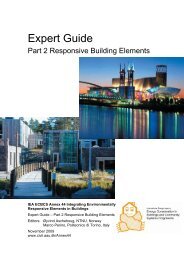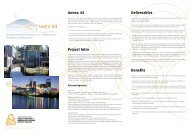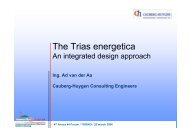Application of Microencapsulated Phase change material Slurry with ...
Application of Microencapsulated Phase change material Slurry with ...
Application of Microencapsulated Phase change material Slurry with ...
- No tags were found...
You also want an ePaper? Increase the reach of your titles
YUMPU automatically turns print PDFs into web optimized ePapers that Google loves.
Progresses <strong>of</strong> Thermal EnergyStorage Using <strong>Microencapsulated</strong>PCM <strong>Slurry</strong> for Low EnergyBuilding <strong>Application</strong>sXichun Wang a , Jianlei Niu a+ , Yi li b , Yinping Zhang ca. Department <strong>of</strong> Building Service Engineering, The Hong Kong Polytechnic Universityb. Institute <strong>of</strong> Textiles and Clothing, The Hong Kong Polytechnic Universityc. Department <strong>of</strong> Building Science, Tsinghua University+Corresponding author: bejlniu@polyu.edu.hk
Outline• Motivation• Properties <strong>of</strong> MPCM slurry• Heat transfer behaviors• <strong>Application</strong>s <strong>of</strong> MPCM slurry• Conclusions
Energy Consumption in theBuilding Sector• Worldwide, 1/3 <strong>of</strong> the energyresources consumed for buildingheating and cooling• An issue <strong>of</strong> combating globalwarming
Low-energy building usingthermal energy storage (TES)1. CoolingTower2. Sky RadiatorTES3. Night-timeOff-peak electricityA/CReduced Electric Power
Technical problems toovercome in PCM applicationsProblemsSolutionsSuitable melting temperatureIncongruent meltingMaterial developmentSupercoolingLiquid/solid phaseVolume <strong>change</strong>Low thermal conductivityMicro-encapsulation( PCM particlesMicro-encapsulated<strong>with</strong> thin plastic shells )
Micro-encapsulated phase <strong>change</strong><strong>material</strong> (MPCM) slurry• Being composed <strong>of</strong> conventionalsingle-phase fluid (e.g. water, oil,etc) and suspended MPCMparticles, a solid-liquid slurry.• MPCM particles:• 10 μm (1/10 <strong>of</strong> our hair diameter):• PCM inside• 0.3 μm thick shell <strong>of</strong> synthetic resin231
Micro-encapsulated PCM(C 16 H 33 ) slurrySEM image
DSC results <strong>of</strong> microencapsulatedhexadecane (C 16 H 34 )
Viscosity measurements (PaarPhysica 300 Rheometer)2520ExperimentsVandRelative viscosity ( - )1510500 5 10 15 20 25 30Concentration (%)
Schematic diagram <strong>of</strong> heattransfer test rigAmmeter3KVA powertransformerAutotransformerInsulatingTransformer220 VVoltmeterFlange 8 T-type thermocouplesT 0.1 0.18 0.18 0.18 0.18 0.18 0.18 0.18 0.1TFlangeData acquisitionsystemstirrerHeat transfer test section1.46 mΔPDifferential pressure transducerBypassFlowmeterValveTPTP5 LMPCM slurry loopValveTPGlycol solutionloopT PRefrigerator<strong>Slurry</strong> reservoirPumpValveFlow meterPlate Heat ex<strong>change</strong>rPump
T lb ,T lw [ o C]Local heat transfer behaviors <strong>of</strong> MPCMslurry (laminar flow)4030201002500Q=292.7WWallPure waterMPCMRegion I Region II Region IIIl0 50 100 150 200 250 300 350hx [W/m 2o C]2000150010005000Churchill and Ozone (1973)MPCM slurry(water)0 50 100 150 200 250 300 350x/Dw p = 0.158, Re lb =1196-1170, m = 4.95 g/s
Local heat transfer behaviors <strong>of</strong> MPCMslurry (Turbulent flow)Tbx, Twx [ o C]hx [W/m 2o C]30252015105Q=802.8WPure waterWallMPCM slurryRegion I Region II Region III0 50 100 150 200 250 300 35070006500MPCM slurry60005500500045004000Choi and cho (1995)(water)350030000 50 100 150 200 250 300 350x/Dw p = 0.05, Re lb =2320-3068, m = 16.4 g/s
Correlation equation(laminar flow)Nupredicted141312111098+10%-10%( )0.4593 0.4836 −0.1277Num = 0.8148Rem PrmSte ⎡ L1+L2/ D⎤−⎣ ⎦Ste =C q R kp, b w d/bw ΔHρ / ρp m p b0.3059766 7 8 9 10 11 12 13 14Nu experimental
Correlation equation(Turbulent flow)605550( ) ⎤−( )−4 0.7733 2.7941 0.31590..333 −2.4349m= 4.8527× 10 Rem Prm⎡1+2/m/wNu Ste ⎣ L L D⎦μ μ45Nu predicted403530+10%-10%25201515 25 35 45 55Nu experimental
Schematic diagram <strong>of</strong> CC <strong>with</strong>MPCM slurry storageExhaustHeat recovery unit (optional)Ceiling panelOutsideAirHumidifierPreheat coilCooling coilReheat coilfanfanpumpRoomRadiatorCondenserCompressorEvaporatorMPCM slurryStorage tank
Load shifting <strong>of</strong> CC running<strong>with</strong> MPCM slurryPower demand (W)12001000800600400200PumpChiller for tankFanChiller for AHUJuly 1501 2 3 4 5 6 7 8 9 10 11 12 13 14 15 16 17 18 19 20 21 22 23 24Time (Hours)MPCM slurry1200Power demand [W]10008006004002000PumpChiller for cold waterFanChiller for AHU1 2 3 4 5 6 7 8 9 10 11 12 13 14 15 16 17 18 19 20 21 22 23 24Time (Hours)water
Yearly energy consumption <strong>of</strong>three systemsThermal energy Chiller (kW.h) Fan Pump Totalstorage medium* water/slurry AHU (kW.h) (kW.h) (kW.h)— 377 614 154 23 1167MPCM slurry (18 o C) 377 614 154 4 1148Ice storage (0 o C) 1801 0 154 25 1980*Note: COP <strong>of</strong> chiller is 4.0 for MPCM slurry storage and 2.2 forice storage.
Annual energy costs <strong>of</strong> threesystems18001600WaterMPCM slurryIce storageAnnual energy cost (HK$)1400120010008006004001 1.2 1.4 1.6 1.8 2 2.2 2.4 2.6 2.8 3Ratio daytime/nighttime Electricity tariff ( - )
Demonstrative CC system
Conclusions• The Hexadecane (C 16 H 34 )is chosen asmicrocapsule core <strong>material</strong> due to higher latentheat and lower supercooling.• The viscosity data measured fit well <strong>with</strong> classicalmodels.• The heat transfer was enhanced significantly dueto the presence <strong>of</strong> MPCM particles.• Two correlations for the design <strong>of</strong> heatex<strong>change</strong>rs <strong>with</strong> MPCM slurry• CC <strong>with</strong> MPCM slurry storage <strong>of</strong>fers the loadshifting, peak load shaving, energy saving as wellas economic benefit.
Acknowledgement• The commitment <strong>of</strong> the project team isappreciated: Pr<strong>of</strong>. Li yi, Song Qingwen at ITCin The Hong Kong PolyU, and• Pr<strong>of</strong>. Zhang Yinping and his team at TsinghuaUniversity• RGC and ITF funding support
QUESTIONS ?





